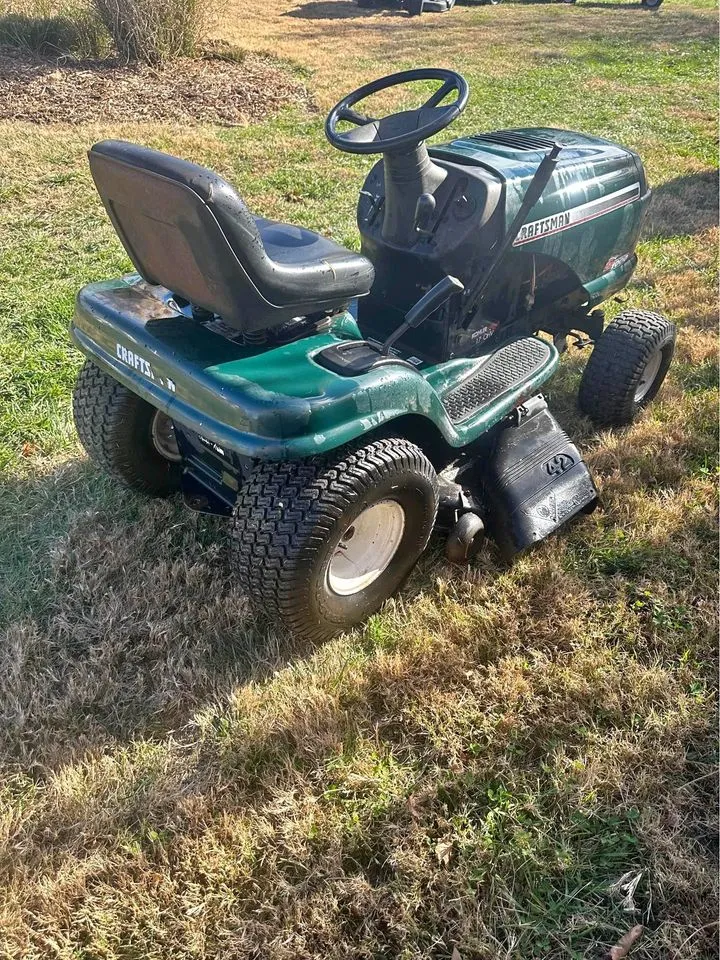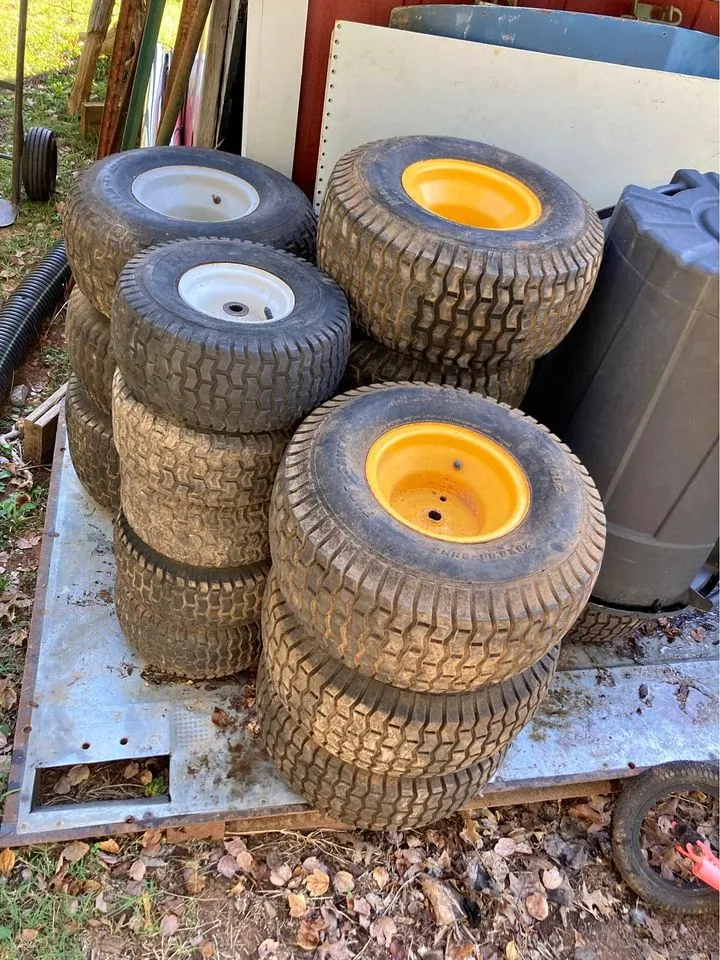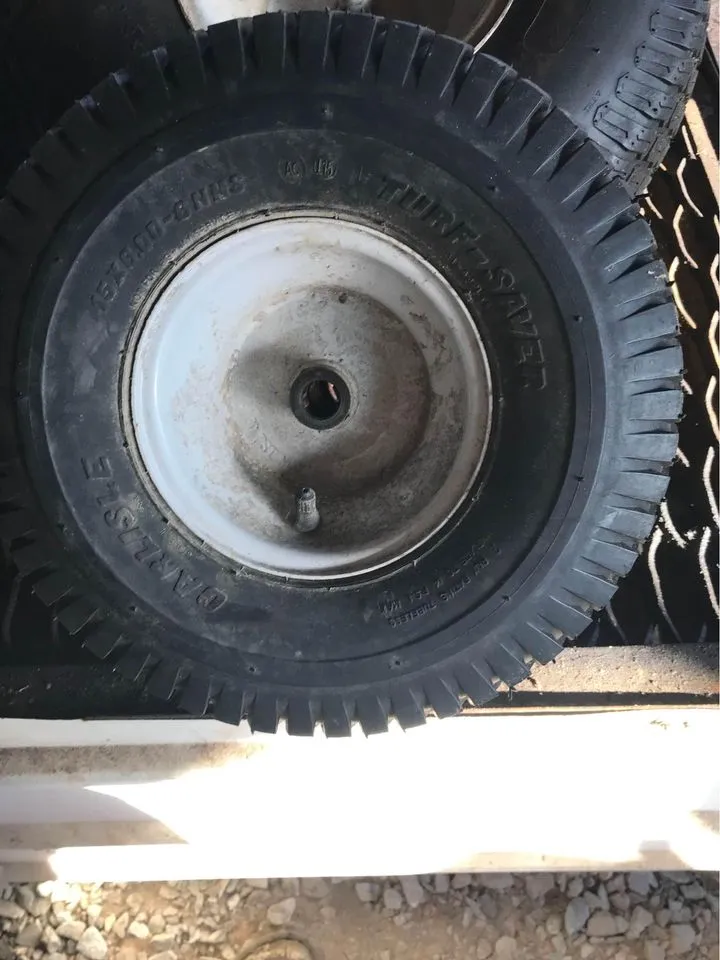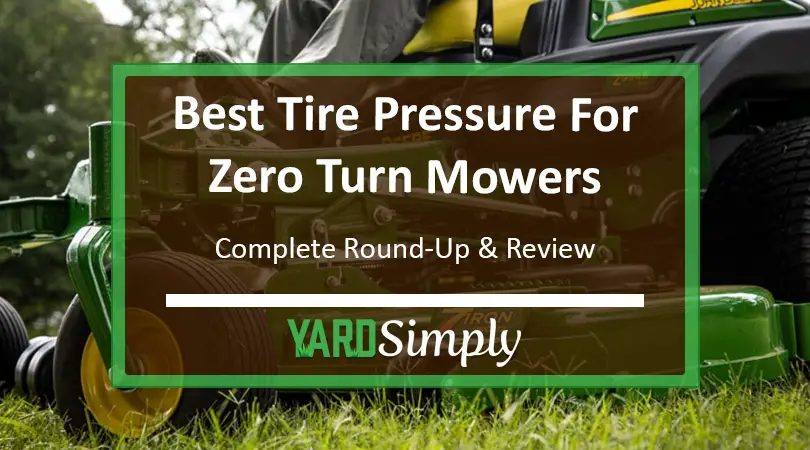As a professional landscaper with over a decade of experience in garden maintenance and machinery, I understand the critical role tire pressure plays in the performance of zero turn mowers.
My extensive hands-on experience has equipped me with insights into the best practices for maintaining optimal tire pressure, ensuring both the longevity of the equipment and the quality of lawn care.
In this article, I’ll share my knowledge to help you maximize the efficiency and lifespan of your zero turn mower by maintaining the ideal tire pressure. Let’s dive into the specifics without delay.
Key Takeaways
- Maintaining optimal tire pressure for zero turn mowers, typically 14 PSI for front tires and 10 PSI for rear tires, is crucial for performance and tire lifespan.
- Incorrect tire pressure can cause uneven cutting patterns, steering difficulties, and visible tire damage.
- Tire pressure should be regularly checked and adjusted, especially in response to temperature changes, as every 10°F drop can decrease pressure by 1-2 PSI.
- In my experience, keeping the right tire pressure not only enhances mowing efficiency but also ensures safety and reduces the need for frequent tire replacements.
Best Tire Pressure for Zero Turn Mowers? (The Short Answer)
For most zero turn mowers, you should keep the front tires at 14 PSI and the rear ones at 10 PSI. However, it’s essential to check your mower’s specific tire sidewalls for any unique PSI recommendations, as this can vary across different brands.
This is especially important for zero turn mowers, which require precise tire pressure for the best performance.
Using a dependable pressure gauge is key to getting accurate PSI readings on your mower’s tires. In my experience, an incorrect reading can lead to adjustments that are not only unnecessary but could also harm your mower.
Remember, correctly maintaining your zero turn mower’s tire pressure is more than just following general guidelines.
It ensures that your mower operates efficiently and has a prolonged life. Incorrect tire pressure can lead to problems like uneven cutting, reduced traction, and even tire damage.
Why It’s Important Your Tire Pressure is Right
Continuing from our previous discussion, it’s crucial to understand why getting your mower’s tire pressure right is so important. Let’s delve into why this is a non-negotiable for your zero turn mowers.
- Performance: Correct tire pressures ensure your lawn mower operates at its optimum. It affects the mower’s speed, turning ability and even the quality of the cut. A smooth, even cut is a direct result of well-maintained tire pressure.
- Safety: Overinflated or underinflated tires can make the mower unstable. This could lead to mower accidents, especially when mowing on slopes. Correct tire pressure ensures that you’re safe and in control.
- Tire Lifespan: Constantly running your mower with incorrect tire pressure can lead to premature wear and tear. You’re looking at replacing your tires sooner than you’d like, which can be an unnecessary expense.
- Efficiency: With the right tire pressure, you’ll spend less time fixing uneven cuts and more time enjoying your beautifully manicured lawn.
Signs of Wrong Tire Pressure

Uneven Cutting Patterns:
- Patchy Lawn: Uneven grass length indicates uneven cutting due to tire pressure issues.
- Steering Difficulty: If steering your mower is hard, it might be due to low tire pressure.
- Excessive Bouncing: Overinflated tires can cause your mower to bounce more than usual.
- Visible Tire Damage: Damages like cracks or bulges on tires suggest incorrect pressure.
Tire Wear Indications:
- Center Wear: Faster wear in the center suggests over-inflation.
- Edge Wear: Faster wear on edges indicates under-inflation.
- Sidewall Damage: Cracks or bulges on the sidewall point to strain from incorrect pressure.
Trouble with Traction:
- Wheel Spin Without Movement: Over-inflated tires may spin without gripping the ground.
- Difficulty Climbing Hills: Under-inflated tires struggle with slopes and inclines.
- Hardworking Hydrostatic Drive: If the drive is laboring without speed, check tire pressure.
- Slipping During Turns: Inability to make sharp turns smoothly can be a tire pressure issue.
How to Make Sure You Have the Best Tire Pressure for Your Riding Mower
To ensure the best tire pressure for your riding mower, there are a few steps you can’t skip.
First, we’ll check the current pressure, then cross-reference it with the manufacturer’s recommendations.
From there, we’ll discuss how to adjust the pressure and verify it’s just right.
Quick Guide to Checking and Adjusting Tire Pressure for Zero Turn Mowers
Step 1: Measure Current Tire Pressure
- Get a Tire Pressure Gauge: Buy a reliable gauge from an auto-parts store.
- Locate Valve Stem: Find the valve stem on your mower’s tire and remove the cap.
- Attach Gauge: Press the gauge onto the valve stem. Adjust if you hear air escaping.
- Read Pressure: Check the gauge for your current tire pressure.
Step 2: Double Check Pressure Ratings
- Compare with Recommended Ratings: Check the tire’s sidewall or mower’s manual for recommended pressure.
- Adjust if Necessary: Use a pump to inflate or deflate if the current pressure doesn’t match the recommended levels.
- Avoid Extremes: Be careful not to overinflate (risk of a flat tire) or underinflate (poor performance).
Step 3: Add or Remove Air
- Recheck Each Tire: Use your tire pressure gauge again.
- Inflate if Low: Add air if the pressure is below the recommended level.
- Deflate if High: Let out some air if the pressure is too high.
- Recheck Pressure: Ensure each tire is at the optimal level.
Step 4: Measure Tire Pressure Again
- Use a Gas Station Pump: Ideal for a quick and accurate adjustment.
- Consider Mower’s Weight: Adjust for your mower’s specific type (battery or gas-powered).
- Final Check: Use the gauge again to confirm the pressure is just right.
- Adjust as Needed: Fine-tune by adding or releasing air if necessary.
Factors To Consider When Determining the Ideal Tire Pressure For Your Zero Turn Mower

When I’m determining the ideal tire pressure for my zero turn mower, I consider several key factors. I’ve learned that maintaining the right tire pressure is crucial for optimal performance and longevity of my mower.
Types of Mowers
Zero Turn Mowers:
- Tire Pressure Sensitivity: These mowers are highly sensitive to tire pressure due to their maneuverability and speed. Incorrect pressure can significantly affect their turning radius and cutting precision.
- Recommendation: Generally, a slightly lower pressure in the rear tires is recommended for better traction and a smoother ride, especially when making sharp turns.
Heavy Duty Zero Turn Mowers:
- For Intensive Use: Designed for extensive, frequent use, often in larger areas or commercial settings.
- Recommendation: May require higher tire pressure to support the additional weight and prevent tire wear, while still maintaining enough flexibility for effective maneuverability.
Residential Zero Turn Mowers:
- For Home Use: Typically lighter and used for smaller, personal lawns.
- Recommendation: Follow manufacturer’s recommended tire pressure, which is usually lower than commercial models, to ensure smooth operation and prevent lawn damage.
- Heavy-Duty Use: These mowers are designed for extensive use and often carry more weight.
- Recommendation: Higher tire pressure within the recommended range is often necessary to support the additional weight and prevent tire wear.
Types of Terrain
Flat and Even Lawns:
- Stable Pressure: Requires consistent tire pressure as fluctuations can lead to uneven cuts.
- Recommendation: Adhere to the manufacturer’s recommended tire pressure for optimal performance.
Rough or Uneven Terrain:
- Increased Traction Needed: Lower tire pressure can provide better traction and a smoother ride over uneven surfaces.
- Recommendation: Slightly lower tire pressure, but not so low as to risk tire damage or rim impact.
Hilly or Sloped Terrain:
- Stability is Key: Requires a balance between traction and stability. Too low pressure can lead to slipping, while too high can cause a bumpy ride and poor control.
- Recommendation: Adjust tire pressure for a balance of stability and traction, considering the steepness of the slopes.
Wet or Slippery Surfaces:
- Traction Challenges: Wet grass or slippery conditions demand better tire grip.
- Recommendation: Slightly lower pressure for increased tire footprint and grip, but maintain enough pressure to prevent the tire from becoming too flexible.
Learn More: Best Push Lawn Mower for Rough Terrain
Temperature and Pressure Relationship

Effects of Cold Weather
- Pressure Drop: In cold weather, the air inside tires contracts, leading to a decrease in pressure. For every 10 degrees Fahrenheit drop in temperature, tire pressure can decrease by about 1-2 PSI. This is why it’s common to find lower tire pressures in vehicles and equipment during winter or in colder regions.
- Impact on Performance: For lawn mowers, this pressure drop can lead to under-inflated tires, affecting traction, maneuverability, and even the quality of the cut on the lawn. Under-inflated tires can also wear out more quickly.
- Regular Checks and Adjustments: It’s important to check tire pressure regularly in colder months and inflate the tires to the recommended level to compensate for the loss of pressure.
Effects of Warm Weather
- Pressure Increase: Conversely, in warm weather, the air inside the tires expands, leading to an increase in pressure. This can result in over-inflation if the tires were already at the upper limit of the recommended pressure range.
- Risks of Over-Inflation: Over-inflated tires can lead to a rougher ride, reduced traction, and uneven wear, particularly in the center of the tread. In extreme cases, it can also increase the risk of tire blowouts.
- Monitoring and Adjustment: During warmer months, it’s advisable to monitor tire pressure and release some air if the pressure exceeds the manufacturer’s recommended levels.
Seasonal Variations and Maintenance
- Seasonal Adjustments: Tire pressure should be adjusted seasonally, taking into account the ambient temperature changes. This ensures that the tires are always within the optimal pressure range.
- Morning Checks: Checking tire pressure in the morning or when the tires are cool gives the most accurate reading, as heat generated from usage can temporarily increase pressure readings.
- Climate-Specific Recommendations: In areas with extreme temperature fluctuations, it might be necessary to check and adjust tire pressure more frequently.
Our Verdict
Based on my years of working with best lawn mowers, maintaining the right tire pressure is a game-changer. I’ve personally seen how 14 PSI for front tires and 10 PSI for rear tires can significantly enhance mower performance and extend tire life.
Whether I’m dealing with cold snaps that drop tire pressure or summer heat that bumps it up, regular checks are a must. From ensuring a smooth cut on various terrains to preventing unnecessary tire wear, the right PSI makes all the difference.
So, always keep your tire pressure in check; your mower, and your lawn, will thank you for it!
Frequently Asked Questions
What Happens if I Use My Zero Turn Mower With Flat Tires?
If you use your zero turn mower with flat tires, it’ll likely result in uneven cuts and potential tire damage. Maneuverability will be reduced, affecting overall performance and possibly causing more serious issues.
How Can Weather Conditions Affect the Tire Pressure of My Zero Turn Mower?
Weather conditions can definitely affect your mower’s tire pressure. Cold temperatures may decrease it, while hot weather can increase it. So, I always check and adjust the pressure according to the current weather conditions.
Can I Use an Automotive Tire Pressure Gauge for My Zero Turn Mower Tires?
Absolutely, I use an automotive tire pressure gauge for my zero turn mower tires. It’s accurate and does the job well. Just remember, always check the pressure when the tires are cool for best results.
Do Different Types of Grass Require Different Tire Pressures for Zero Turn Mowers?
No, different types of grass don’t require different tire pressures for zero turn mowers. It’s the mower’s weight and the terrain that can impact tire pressure, not the grass type you’re mowing.
How Often Should I Replace the Tires on My Zero Turn Mower?
I replace my zero turn mower’s tires about every 5-7 years, but it depends on usage and tire condition. If they’re damaged or worn out before that, I replace them sooner for safety and performance.


